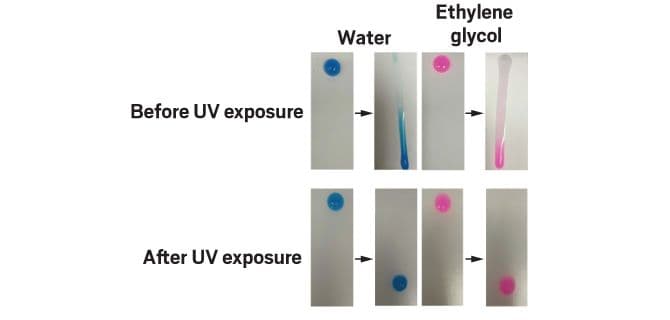Surfaces that ward off liquids can keep ice off roofs, bacterial films off medical implants, and barnacles off ships. In an effort to keep such surfaces slippery for longer periods of time, researchers have developed a new kind of liquid-repelling coating that can heal itself when damaged. A slippery liquid-repellent coating is made of silicone […]

Surfaces that ward off liquids can keep ice off roofs, bacterial films off medical implants, and barnacles off ships. In an effort to keep such surfaces slippery for longer periods of time, researchers have developed a new kind of liquid-repelling coating that can heal itself when damaged.
A slippery liquid-repellent coating is made of silicone oil-loaded microscopic capsules designed to break open when exposed to UV light. Blue-dyed water and red-dyed ethylene glycol stick to the coating before UV exposure (top, before and after tilting to 90°), but after UV exposure, the capsules release the lubricating oil that makes liquid droplets roll off the surface easily (bottom, before and after tilting to 10°).
The new material has a much longer service life and is better at self-healing than previous coatings, says Limin Wu, a materials scientist at Fudan University who led the work. It maintains its liquid-repelling properties even when scratched or exposed to harsh chemicals and heat.
The material follows in a long line of liquid-repelling coatings that have been inspired by nature. For example, hydrophobic coatings based on the microscopic structures of lotus leaves rely on air pockets to keep liquids from sticking to the surface. And in 2011, researchers at Harvard University mimicked the pitcher plant to make slippery, liquid-infused porous surfaces (SLIPS), which are sponge-like nanowire networks that hold droplets of oil-and-water-repelling fluids within their cavities. A thin layer of the fluid lubricates the surface, repelling all sorts of liquids. But the lubricant can slowly drain out of the surface over time via evaporation at high temperatures, mechanical abrasion, or being flushed away by solvents. The substrates can be refilled with the fluid but that is costly on a large scale, Wu says. So he and his colleagues designed a coating that would work on similar principles without needing to be refilled.
The coating is based on a commercial latex mixed with spherical polymer microcapsules, which are filled with silicone oil and coated with titanium dioxide nanoparticles. Titanium dioxide, a white paint pigment, is also a well-known photocatalyst. When UV light hits the coating, it triggers the titanium dioxide to break down the polymer shell of the capsules, releasing a lubricating layer of silicone oil.
The researchers tested the coating’s ability to repel water and low-surface-tension liquids such as ethylene glycol and acetonitrile. After the coating was exposed to UV light, the liquids easily slid off the surface when it was tilted at a 10° angle. The coating retained its slipperiness after being heated at 40°C for eight days, being frozen at -20°C for 10 days, or being immersed in acidic or alkaline solutions for six hours.
When the surface of the coating is damaged, it exposes more microcapsules beneath the surface that release oil once exposed to UV light. The researchers demonstrated this self-repair mechanism by stripping the liquid repellent from the surface using ethanol, or by scratching the surface of the material, and then exposing the surfaces to UV light. In both cases, this exposure restored the surface’s liquid repellence.
It might take some finessing to make these coatings more practical. The angle required to slide droplets down the slippery surface is 1–2° for conventional SLIPS, says Jonathan B. Boreyko, a mechanical engineer at Virginia Tech who was not involved in this work, “so it seems like this new technology is less slippery.” Moreover, the UV intensity required to break down the capsules is about 10 times higher than that of sunlight, says Tak-Sing Wong, a mechanical engineer at Pennsylvania State University. Wu says that his team is now working on capsules that release oil more easily, so that the coatings are more practical.
This article is reproduced with permission from C&EN (© American Chemical Society). The article was first published on September 26, 2018.
